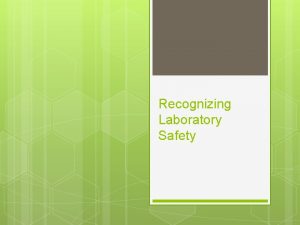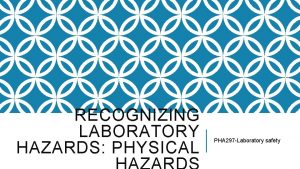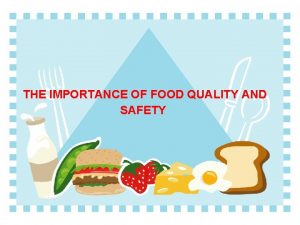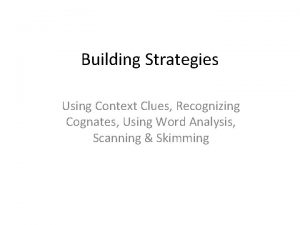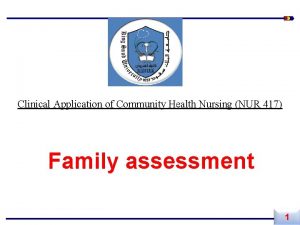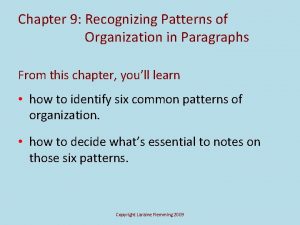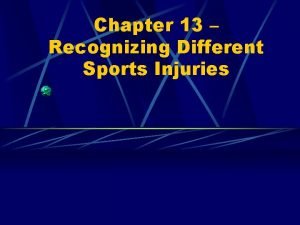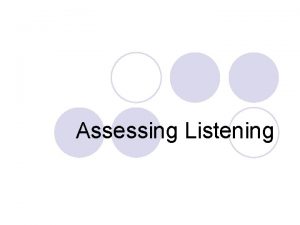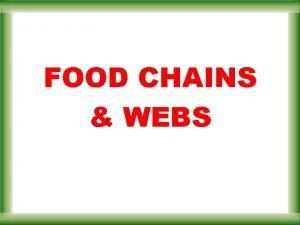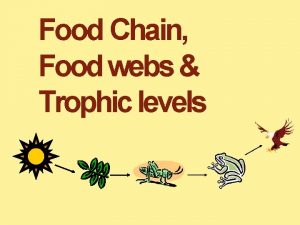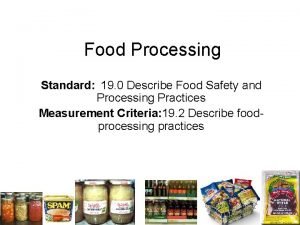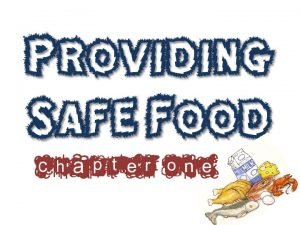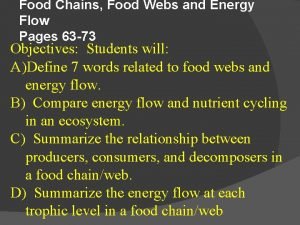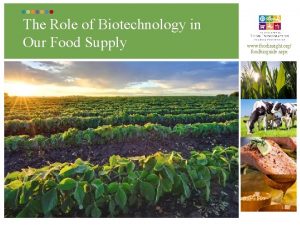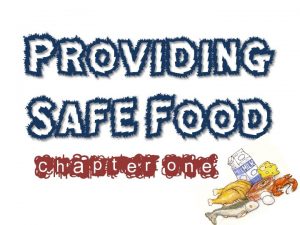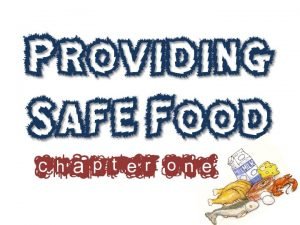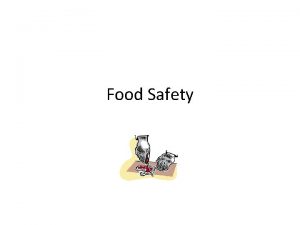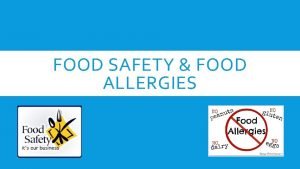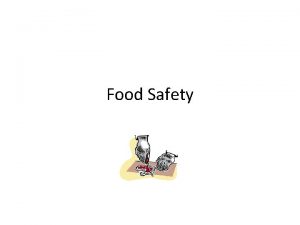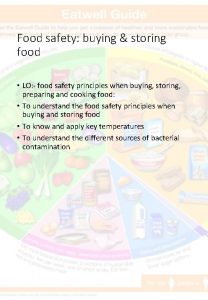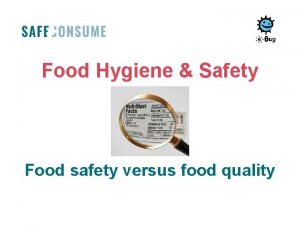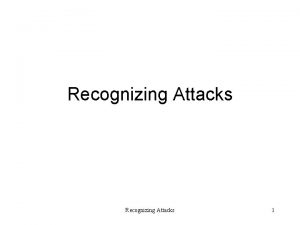Recognizing the importance of food safety Understanding how





















































































- Slides: 85


• Recognizing the importance of food safety • Understanding how food becomes unsafe • Identifying TCS Food • Recognizing the risk factors for foodborne illness • Understanding important prevention measures for keeping food safe

• Foodborne illness- a disease transmitted to people by food

• Each year millions of people get sick from unsafe food. • Challenges to food safety in this class may include: – Time: Pressure to work quickly can make it hard to take the time to follow food safety practices. – Pathogens: Illness-causing microorganisms are more frequently found on food that was once considered safe (ex. Salmonella)

• To prevent foodborne illness, you must recognize the hazards that can make food unsafe: – Pathogens – Chemicals – Objects – Certain unsafe practices • Most of these hazards can be controlled by focusing on personal hygiene, time & temperature control, and cross contamination.

• Potential hazards to food safety are divided into three categories: – Biological – Chemical – Physical

• Pathogens are the greatest threat to food safety. • They include viruses, parasites, fungi, and bacteria. • Some plants, mushrooms, and seafood that carry harmful toxins (poisons) are also included in this group.

• Chemicals can contaminate food if they are used incorrectly. • This group also includes cleaners, sanitizers, and toxic metals that leach from cookware into food.

• Foreign objects like hair, dirt, bandages, metal, staples, or broken glass can get into food. • Naturally occurring objects, like fish bones in fillets, are also physical hazards.

• The Centers for Disease Control and Prevention (CDC) has identified the five most common risk factors that cause foodborne illnesses: – Purchasing food from unsafe sources – Failing to cook food adequately – Holding food at incorrect temperatures – Using contaminated equipment – Practicing poor hygiene

• Food has been time-temperature abused when it has stayed too long at temperatures that are good for growth of pathogens. A foodborne illness can result if food is time-temperature abused, which can happen in many ways: • Food is not held or stored at the right temperature • Food is not cooked or reheated enough to kill pathogens • Food is not cooled the right way

• Pathogens can be transferred from one surface or food to another. Crosscontamination cause a foodborne illness in many ways: – Contaminated ingredients are added to food that receives no further cooking – Ready-to-eat food touches contaminated surfaces – Contaminated food touches or drips fluids onto cooked or ready-to-eat food – A food handler touches contaminated food and then touches ready-to-eat food – Contaminated cleaning towels touch food-contact surfaces

• Foodhandlers can cause a food borne illness if they do any of the following actions: – Fail to wash their hands the right way after using the restroom or after any time their hands get dirty – Come to school while sick – Cough or sneeze on food – Touch or scratch wounds, and then touch food

• Focus on: – Controlling time & temperature – Preventing cross contamination – Practicing personal hygiene – Purchasing from approved reputable suppliers

• TCS Food: Food requiring time and temperature control for safety. • The next few slides have foods that are considered TCS foods and need time and temperature control to limit the growth of pathogens.

• Milk & Dairy Products • Meat: beef, pork and lamb • Fish • Heat treated plant food, such as cooked rice, beans and vegetables

• Tofu or other soy protein • Synthetic ingredients such as textured soy protein in meat alternatives • Sliced Melon • Cut Tomatoes • Cut Leafy Vegetables

• Shell Eggs • Poultry • Shellfish and crustaceans

• What is wrong with the following situations: time-temperature abuse, poor personal hygiene, or cross contamination 1) A package of raw chicken breasts is left out at room temperature. 2) A foodhandler sneezes on a salad. 3) A foodhandler cooks a rare hamburger. 4) A foodhandler scratches a cut, and then continues to make a sandwich.

• What is wrong with the following situations: time-temperature abuse, poor personal hygiene, or cross contamination 5) A foodhandler leaves the restroom without washing their hands. 6) A foodhandler cuts up raw chicken. He then uses the same knife to chop carrots for a salad.

• Several government agencies take leading roles in the prevention of foodborne illness in the U. S.

• The Food and Drug Administration inspects all food except meat, poultry and eggs. • The agency also regulates food transported across state lines. • In addition, the FDA issues a Model Food Code. This science-based code provides recommendations for food safety regulations.

• The U. S. Department of Agriculture regulates and inspects meat, poultry, and eggs. • The USDA also regulates food that crosses state boundaries or involves more than one state.

• The Centers for Disease Control and Prevention and the U. S. Public Health Services help assist the FDA, and local and state health departments. • They conduct research into the causes of foodborne-illness outbreaks. • They also assist in investigating outbreaks.

• State and Local Regulatory authorities writes or adapt code that regulates retail and foodservice operations. • Codes may differ from the FDA Model Food Code, because these agencies are not required to adopt it. • Here are some of the responsibilities related to food safety: – Inspecting operations – Enforcing regulations – Investigating complaints and illnesses – Issuing licenses and permits – Approving construction – Reviewing and approving HACCP plans


• Contamination- the presence of harmful substances (biological, chemical or physical) in food • Can be contaminated on purpose, but most cases are accidents.

• Animals used for food • Air, contaminated water, and dirt • People – From person to person – Through sneezing or vomiting onto food or food contact surfaced – From touching dirty food-contact surfaces and equipment, and then touching food


• Microorganisms- small, living organisms that can be seen only through a microscope. Many are harmless, but some can cause illness. • Harmful microorganisms=pathogens • Some pathogens make you sick when you eat them, while others produce poisons —or toxins—that make you sick

• • • Diarrhea Vomiting Fever Nausea Abdominal cramps Jaundice- yellowing of the skin and eyes

• Not every person will have all of the symptoms listed. • Nor are the symptoms of a foodborne illness limited to this list • Onset times (how quickly symptoms appear in a person) depend on the type of foodborne illness. Range 30 min- 6 weeks • Severity can vary from nausea to death

• Location – Can be found almost anywhere – Live in our bodies – Some keep us healthy, while others cause illness

• Detection – Can’t be seen – Can’t be smelled – Can’t be tasted

• Growth – Grows rapidly if FAT TOM conditions are right

• Food- Needs nutrients to grow; grows best in TCS Foods • Acidity- Grows best in little or no acid • Temperature- Grows best in the temperature danger zone (41 -135) • Time- Needs time in the temp. danger zone • Oxygen- Some need oxygen, while others don’t • Moisture- Grows best in food with high levels of moisture

• Prevention: – CONTROL TIME AND TEMPERATURE

• The FDA has identified 3 types of bacteria that are highly contagious and can cause severe illness.

• Only lives in humans • Eating only a small amount can make a person sick. • Severity of symptoms depends on the health of a person

• Food linked with bacteria – Ready-to-eat food – beverages • Prevention Measures – Exclude food handlers who have been diagnosed – Wash hands – Cook food to minimum internal temperatures

• Flies transfer the bacteria into the food • Eating only a small amount can make a person sick • High levels of the bacteria are found for weeks after symptoms have ended.

• Food linked with bacteria – Foods that is easily contaminated by hands – Food that has made contact with contaminated water, such as produce • Prevention Measures – Exclude food handlers who have been diagnosed – Exclude food handlers who have diarrhea – Wash hands – Control flies inside and outside of the operation

• Can be found in the intestines of cattle • Also found in infected people • Can contaminate meat during slaughtering • Eating only a small amount can get you sick • Once eaten, produces toxins in the intestines, which causes the illness. • Bacteria often found in a person for weeks after symptoms have ended

• Food linked with bacteria – Ground beef (raw and undercooked) – Contaminated produce • Prevention Measures – Exclude food handlers who have been diagnosed – Cook food to minimum internal temperatures – Purchase produce from approved, reputable suppliers – Prevent cross-contamination between raw meat and ready-to-eat food

• Location – Carried by humans and animals – Require a living host to grow – While they do not grow in food, viruses can be transferred through food and remain infectious in food

• Source – You can get a virus from food, water or any contaminated surface

• Destruction – Viruses are not destroyed by normal cooking temps – Important to practice good personal hygiene when handling food and foodcontact surfaces – Quick removal of vomit is also important

• Can contaminate water and many types of food. • The virus is often transferred to food when infected food handlers touch food or food equipment with fingers. • Cooking does not destroy.

• Food Linked with the Virus – Ready-to-eat food – Shellfish form contaminated water • Prevention Measures – – – Exclude people who have been diagnosed Exclude people who have jaundice Wash hands Avoid bare-hand contact with ready-to-eat food Purchase shellfish from approved, reputable suppliers

• Often transferred to food when infected food handlers touch food or equipment with fingers • Eating only a small amount can make you sick • People become contagious within a few hours after eating it

• Food linked with the Virus – Ready-to-eat food – Shellfish from contaminated water • Prevention Measures – Exclude people who have been diagnosed – Exclude people with diarrhea and vomiting from the operation – Wash hands – Avoid bare-hand contact with ready to eat food – Purchase shellfish from approved, reputable suppliers

• Location – Require a host to live and reproduce • Sources – Commonly associated • Seafood • Wild game • Food processed with contaminated water, such as produce

• Prevention – Most important way to prevent a foodborne illness by a parasite is to purchase food from approved, reputable suppliers. – Cooking food to required minimum internal temperatures is also important. – Make sure that fish that will be served raw or undercooked has been correctly frozen by the manufacturer

• Fungi includes yeasts, molds, and mushrooms • Some molds and mushrooms produce toxins that cause foodborne illness • Throw out all moldy food, unless the mold is a natural part of the food • Because mushrooms are difficult to recognize, you must purchase all mushrooms from approved, reputable suppliers.

• Origin – Natural part of some fish – Histamine is made by pathogens on some fish (tuna, bonita, mackerel and mahi) when it is time-temperature abused – Some fish become contaminated when they eat smaller fish with a toxin – Shellfish (like oysters) can be contaminated when they eat marine algae that have a toxin

• Symptoms – Many type of illnesses occur from eating seafood toxins, and each of those toxins have their own set of symptoms – People will experience an illness within minutes of eating the toxin – Examples of symptoms: diarrhea, vomiting, tingling in the extremities, reversal of hot and cold sensation, flushing of the face, difficulty breathing, burning in the mouth, heart palpitations, and hives

• Prevention – Toxins cannot be destroyed by cooking or freezing – Purchase plants mushrooms, and seafood from approved, reputable suppliers – Control time and temperature when handling raw fish

• Sources – Cleaners – Pesticides – First aid products – Health and beauty products

• Sources – Toxic metals • • Pewter Copper Zinc Some types of painted pottery • -NOT FOOD GRADE!!!!

• Symptoms – Vary depending on the chemical consumed – Most illnesses occur within minutes – Vomiting and diarrhea are typical – Call poison control of chemical contamination is suspected

• Prevention – Purchase chemicals from approved, reputable suppliers – Store chemicals away from prep areas, food storage areas and service areas – Use chemical for their intended use and follow the manufacturer’s directions – Only handle food with equipment and utensils approved for foodservice use

• Sources – Metal shavings from cans – Fingernails – Staples – Bandages – Glass – Jewelry – Naturally occurring objects such as fruit pits and bones

• Symptoms – Mild to fatal injuries possible – Could include: • Dental damage • Cuts • Choking

• Prevention – Purchase food from approved reputable suppliers – Closely inspect food received – Take steps to make sure no physical contaminants can get into food – Make sure food handlers practice good personal hygiene

• Food allergen- A protein in a food or ingredient that some people are sensitive to • These proteins are naturally occurring • When enough of an allergen is eaten, an allergic reaction can occur

• Depending on the person, an allergic reaction can happen just after the food is eaten or several hours later. – Nausea – Wheezing or shortness of breath – Hives or itchy rashes – Swelling of various parts of the body, including the face, eyes, hands or feet – Abdominal pain

• Initially symptoms may be mild, but they can become serious quickly. • In severe cases, anaphylaxis—a severe allergic reaction that can lead to death—may result.

• • Milk Eggs Fish Shellfish Wheat Soy Peanuts Tree nuts


When they have a foodborne illness When they have wounds that contain a pathogen When sneezing or coughing When they have contact with a person who is ill When they touch anything that may contaminate their hands and then they don’t wash them • When they have symptoms such as diarrhea, vomiting or jaundice • • •

• Carriers- people who carry pathogens and infect others without ever getting sick • Staphylococcus aureus is a pathogen carried in the nose of 30 to 50 percent of healthy adults. Foodhandlers transfer this type of bacteria to food when they touch the infected areas of their bodies and then touch food without washing their hands.

• WATCH WHAT YOU DO WITH YOUR HANDS! – Running fingers through the hair – Wiping or touching the nose – Touching your clothes – Coughing or sneezing into the hand

• Hand practices – Handwashing – Hand care – Glove use – Preventing bare-hand contact with ready-to-eat food • Personal cleanliness • Clothing, hair restraints and jewelry 73

• Most important part of personal hygiene is hand washing • Many food handlers do not wash their hands the correct way or as often as they should • Hands must be washed! • There are 5 steps in the proper hand washing rountine, and the whole thing should take AT LEAST 20 seconds

• Wet hands and arms – Use running water as hot as you can comfortably stand – It should be at least 100 F

• Apply soap – Apply enough to build up a good lather

• Scrub hands and arms vigorously – Scrub them for 10 to 15 seconds. – Clean under fingernails and between fingers.

• Rinse hands and arms thoroughly – Using running warm water

• Dry hands and arms – Use a single-use paper towel or a hand dryer

• If you are not careful, you can contaminate your hands after washing them. • Consider using a paper towel to turn off the faucet and to open the door when leaving the restroom 80

• • • Before you start work After using the restroom After handling raw meat After touching the hair, face or body After sneezing, coughing, or using a tissue After handling chemicals that might affect food safety • Touching clothing or aprons • After leaving and returning to the kitchen/prep area

• Hand antiseptics are liquids or gels that are used to lower the number of pathogens on skin. • Only use hand antiseptics AFTER handwashing. • NEVER use in place of handwashing. • Wait for hand antiseptic to dry before touching food or equipment.

• Single use gloves can help keep food safe by creating a barrier between hands and food. • Should be used when handling ready-to-eat food • Gloves should never be used in place of handwashing! • NEVER wash and reuse gloves • NEVER blow into glove

• As soon as they become dirty or torn • Before beginning a different task • After handling raw meat, seafood, or poultry, and before handling ready-to-eat food

• Pathogens can be found on hair and skin, and they can be transferred to food and food equipment if the food handler does not follow a personal hygiene program.
 Recognizing lab safety worksheet answer key
Recognizing lab safety worksheet answer key Recognizing laboratory safety
Recognizing laboratory safety Importance of quality food
Importance of quality food Food safety food security
Food safety food security Unit 2 food food food
Unit 2 food food food Food chain sequence
Food chain sequence How would you differentiate useful from harmful materials?
How would you differentiate useful from harmful materials? The listening wheel
The listening wheel Recognizing opportunity
Recognizing opportunity Observing trends in entrepreneurship
Observing trends in entrepreneurship Recognizing genre - argumentative text
Recognizing genre - argumentative text Marketing channel structures
Marketing channel structures Recognizing opportunities and generating ideas
Recognizing opportunities and generating ideas Entrepreneurial trends
Entrepreneurial trends An opportunity has four essential qualities it is
An opportunity has four essential qualities it is Strategy: recognizing cognates
Strategy: recognizing cognates How to do an argumentative essay introduction
How to do an argumentative essay introduction Chapter 3 recognizing opportunity
Chapter 3 recognizing opportunity I have always enjoyed reading the book more than
I have always enjoyed reading the book more than Personal pronouns
Personal pronouns Recognizing and resolving abo discrepancies
Recognizing and resolving abo discrepancies Recognizing interruptions of health development
Recognizing interruptions of health development Patterns of organization
Patterns of organization Chapter 13 worksheet recognizing different sports injuries
Chapter 13 worksheet recognizing different sports injuries Recognizing phonological and morphological elements
Recognizing phonological and morphological elements Recognizing imagery
Recognizing imagery What is channel design in marketing
What is channel design in marketing Chapter 3 recognizing opportunity
Chapter 3 recognizing opportunity Adverb and adjective examples
Adverb and adjective examples Recognizing opportunities and generating ideas
Recognizing opportunities and generating ideas Decentralized network
Decentralized network Hát kết hợp bộ gõ cơ thể
Hát kết hợp bộ gõ cơ thể Bổ thể
Bổ thể Tỉ lệ cơ thể trẻ em
Tỉ lệ cơ thể trẻ em Gấu đi như thế nào
Gấu đi như thế nào Chụp tư thế worms-breton
Chụp tư thế worms-breton Chúa sống lại
Chúa sống lại Các môn thể thao bắt đầu bằng tiếng nhảy
Các môn thể thao bắt đầu bằng tiếng nhảy Thế nào là hệ số cao nhất
Thế nào là hệ số cao nhất Các châu lục và đại dương trên thế giới
Các châu lục và đại dương trên thế giới Công thức tính độ biến thiên đông lượng
Công thức tính độ biến thiên đông lượng Trời xanh đây là của chúng ta thể thơ
Trời xanh đây là của chúng ta thể thơ Mật thư tọa độ 5x5
Mật thư tọa độ 5x5 Làm thế nào để 102-1=99
Làm thế nào để 102-1=99 Phản ứng thế ankan
Phản ứng thế ankan Các châu lục và đại dương trên thế giới
Các châu lục và đại dương trên thế giới Thể thơ truyền thống
Thể thơ truyền thống Quá trình desamine hóa có thể tạo ra
Quá trình desamine hóa có thể tạo ra Một số thể thơ truyền thống
Một số thể thơ truyền thống Cái miệng xinh xinh thế chỉ nói điều hay thôi
Cái miệng xinh xinh thế chỉ nói điều hay thôi Vẽ hình chiếu vuông góc của vật thể sau
Vẽ hình chiếu vuông góc của vật thể sau Nguyên nhân của sự mỏi cơ sinh 8
Nguyên nhân của sự mỏi cơ sinh 8 đặc điểm cơ thể của người tối cổ
đặc điểm cơ thể của người tối cổ Ví dụ giọng cùng tên
Ví dụ giọng cùng tên Vẽ hình chiếu đứng bằng cạnh của vật thể
Vẽ hình chiếu đứng bằng cạnh của vật thể Phối cảnh
Phối cảnh Thẻ vin
Thẻ vin đại từ thay thế
đại từ thay thế điện thế nghỉ
điện thế nghỉ Tư thế ngồi viết
Tư thế ngồi viết Diễn thế sinh thái là
Diễn thế sinh thái là Các loại đột biến cấu trúc nhiễm sắc thể
Các loại đột biến cấu trúc nhiễm sắc thể Số nguyên là gì
Số nguyên là gì Tư thế ngồi viết
Tư thế ngồi viết Lời thề hippocrates
Lời thề hippocrates Thiếu nhi thế giới liên hoan
Thiếu nhi thế giới liên hoan ưu thế lai là gì
ưu thế lai là gì Hổ sinh sản vào mùa nào
Hổ sinh sản vào mùa nào Khi nào hổ con có thể sống độc lập
Khi nào hổ con có thể sống độc lập Hệ hô hấp
Hệ hô hấp Từ ngữ thể hiện lòng nhân hậu
Từ ngữ thể hiện lòng nhân hậu Thế nào là mạng điện lắp đặt kiểu nổi
Thế nào là mạng điện lắp đặt kiểu nổi Ecdis safety settings
Ecdis safety settings Safety care training
Safety care training Personal safety vs process safety
Personal safety vs process safety Safety assessment for ind safety reporting
Safety assessment for ind safety reporting Basic safety (construction site safety orientation)
Basic safety (construction site safety orientation) Construction site safety orientation
Construction site safety orientation Antartic food web
Antartic food web Importance of food chains
Importance of food chains Which best summarizes the flow of energy in a producer
Which best summarizes the flow of energy in a producer Importance of food processing
Importance of food processing Which food is a tcs food
Which food is a tcs food Significance of food web
Significance of food web Foodinsight.org
Foodinsight.org
